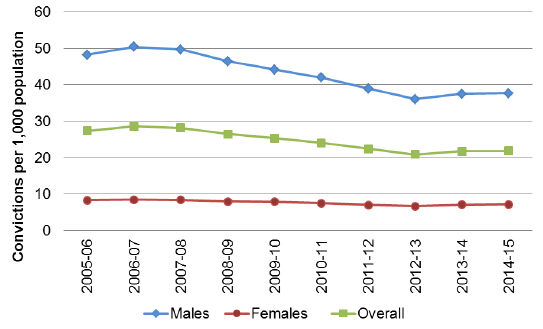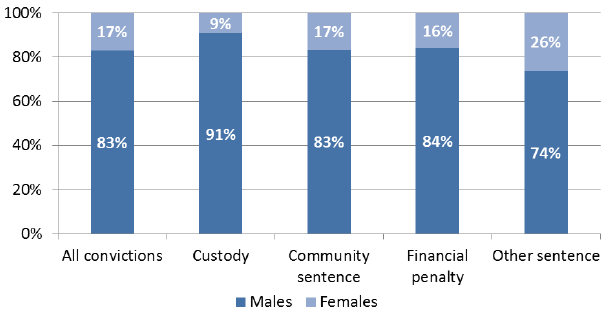CRIMINAL PROCEEDINGS IN SCOTLAND 2014-15
Summary of offences dealt with by courts, sentencing outcomes and characteristics of convicted offenders. Additional information on non-court penalties issued by the Police and Crown Office & Procurator Fiscal Service.
13. Age and Gender
In 2014-15 there were 22 convictions per 1,000 members of the population (1 in every 45 people). The rate for males was higher at 38 convictions per 1,000 population compared to 7 for females.
The overall conviction rate has declined over the last ten years from 27 convictions per 1,000 population in 2005-06. The rate reached 22 convictions per 1,000 in 2011-12 and has since stabilised. The decline has been driven by a decrease for males, down to 38 convictions per 1,000 population in 2014-15 from 48 in 2005-06. The rate for females has remained stable over the ten years, ranging between 7 and 8 convictions per 1,000 population.
Chart 12: Convictions per 1,000 population by gender, 2005-06 to 2014-15

Over the past 10 years the gap between the number of convictions per 1,000 population for younger people compared to older people has become smaller. This has been driven by a fall in the number of convictions per 1,000 population for younger people, whilst the rate for older people (aged 31 or above) has remained relatively stable.
In 2005-06 the age with the highest conviction rate was those aged 18 at 102 convictions per 1,000 population. Since 2005-06 the age with the highest conviction rate has shifted upwards. The highest conviction rate was for those aged 26-30 in 2014-15 and stood at 51 convictions per 1,000 population. Conviction rates by age follow similar trends for both males and females.
Convictions by gender/age and crime type
Males accounted for 83 per cent of all convictions in 2014-15 (where the gender was known), unchanged from 2013-14. More males than females were convicted in all crime/offence categories except for offences associated with prostitution (57% of all convictions were for females).
Whilst females accounted for 17 per cent of all convictions they accounted for higher proportions of convictions for the following crime types in 2014-15:
- 38 per cent of all other violence convictions;
- 33 per cent of all fraud convictions ; and
- 28 per cent of all shoplifting convictions.
In 2014-15, common assault was the most common offence for people under the age of 21. More than a quarter (27 per cent) of female under 21 convictions were for common assault with the corresponding figure for males being 15 per cent. By contrast common assault accounted for smaller proportions of convictions for both men and women aged over 30 (11 and 9 per cent for males and females respectively).
Convictions for motor vehicle offences accounted for higher proportions of convictions for those aged over 30; 42 per cent of males convicted and 40 per cent of females convicted. This compares to the under 21-age group where 19 per cent of males and females convicted were done so for motor vehicle offences.
Sentencing by gender and age
Chart 13: Total Convictions and Disposal Type by gender, 2014-15

Males accounted for 83 per cent of all people convicted in 2014-15 but represented a higher proportion of all custodial sentences (91 per cent). By contrast females accounted for 17 per cent of people convicted compared to a lower proportion for custodial sentences (9 per cent of custodial sentences). Females were more likely to be issued with an “Other sentence” with 26 per cent of these types of punishments been given to females compared to the 17 per cent of all convictions that females represent. “Other sentences” are mostly admonishments i.e. a verbal warning from the sheriff.
Please note that sentencing decisions are reflective of a number of factors such as the severity of the crime and whether the individual has offended in the past. In addition, the decision will be based on circumstances of the offender to what type of punishment is reasonable. These statistics do not take account of these factors.
Table 12 illustrates a complex picture of trends for the different court disposals by age and gender. Table C summarises the main changes over the last ten years. It shows that for all disposal types there have been decreases in numbers for those aged “under 21” and “21-30” for both males and females with the exception of community sentences for males aged 21-30 where there has been an increase in the last 10 years, up by 17 per cent to 5,752 people. Financial penalties are the only disposal types where the trend is consistent for all age-gender groups with them all showing a decline.
Table C: Key changes in disposals by age and gender, 2005-06 to 2014-15
Type of disposal |
NATIONAL CHANGE |
MALE |
FEMALE |
|---|---|---|---|
Custodial sentences |
Decline of 7 per cent from 15,081 people in 2005-06 to 13,977 in 2014-15 |
9% decrease for males overall |
13% increase for females overall |
Decreases by age for:
|
Decreases by age for:
|
||
Increases by age for:
|
Increases by age for:
|
||
Community sentences |
Rise of 16 per cent from 15,974 people in 2005-06 to 18,519 in 2014-15 |
16% increase for males overall |
17% increase for females overall |
Decreases by age for:
|
Decreases by age for:
|
||
Increases by age for:
|
Increases by age for:
|
||
Financial penalties |
Decline of 31 per cent from 82,194 people in 2005-06 to 56,843 in 2014-15 |
31% decrease for males overall |
27% decrease for females overall |
Decreases for all age groups:
|
Decreases for all age groups:
|
Contact
Email: Gillian Diggins
There is a problem
Thanks for your feedback